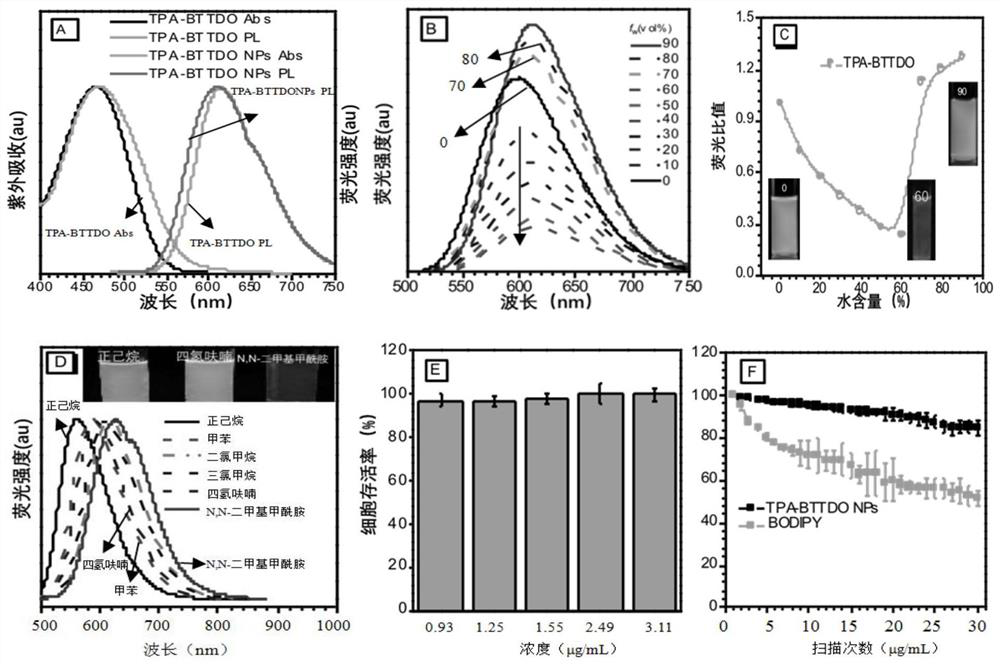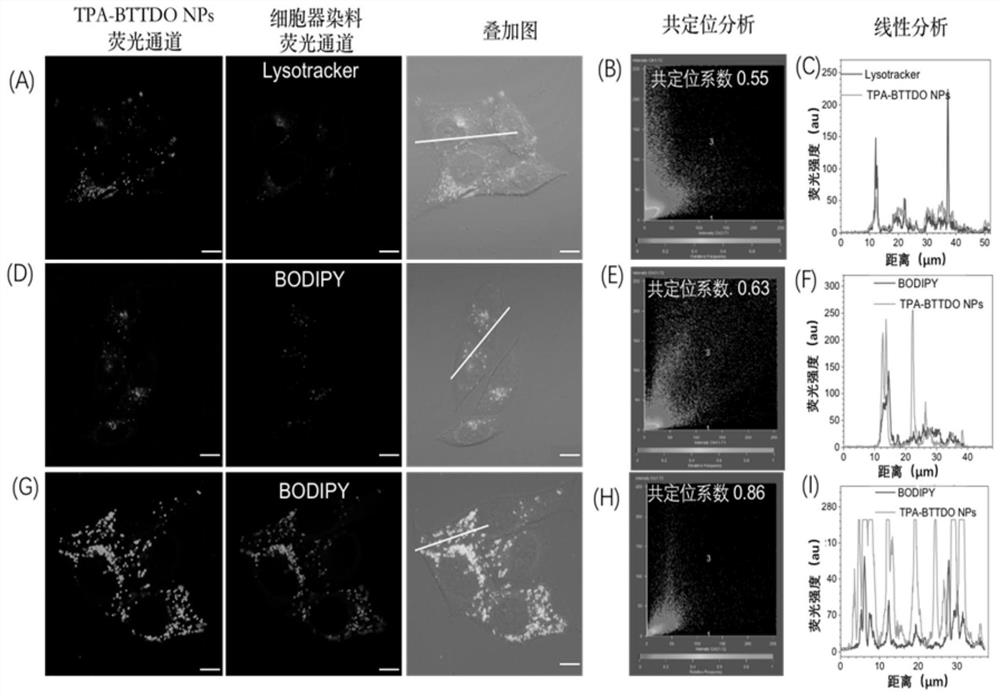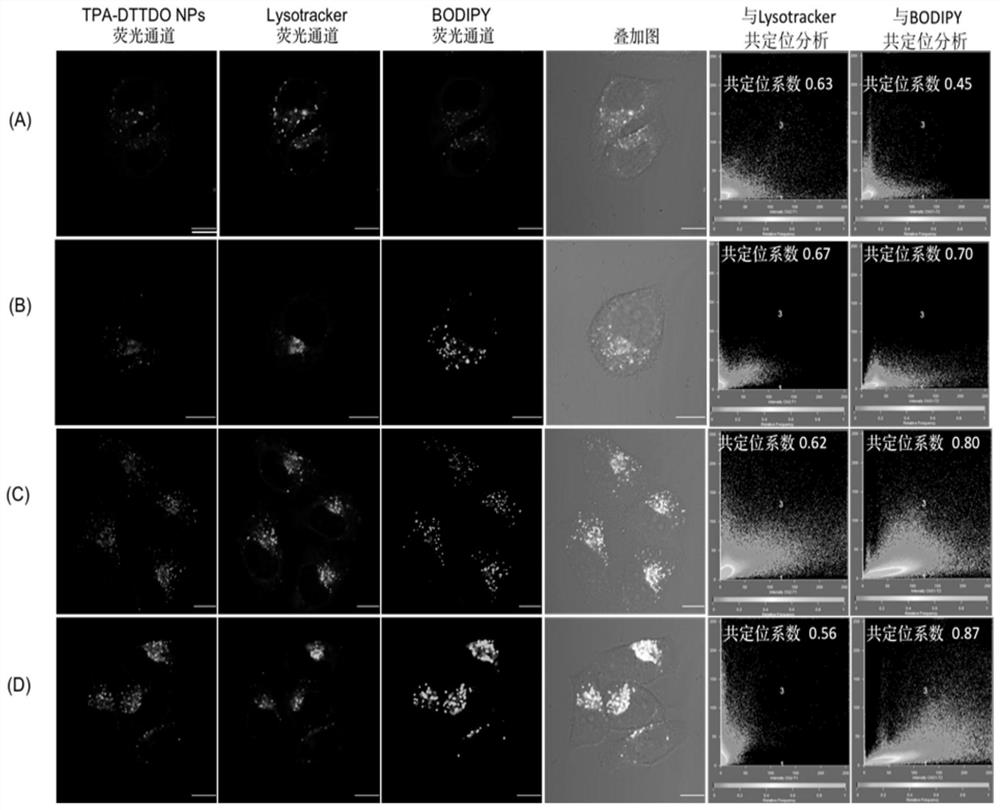A Fluorescent Probe Based on Fused-epoxythiophene and Its Application in Cell Imaging
A fluorescent probe and cell imaging technology, applied in the fields of organic chemistry and chemical biology, to achieve the effects of high biocompatibility, simple operation and high sensitivity
- Summary
- Abstract
- Description
- Claims
- Application Information
AI Technical Summary
Problems solved by technology
Method used
Image
Examples
preparation example Construction
[0054] The preparation steps of TPA-BTTDO are:
[0055] (1) Synthesis of intermediate 1
[0056] 3,6-Dibromothieno[3,2-b]thiophene (1.49g, 5mmol), phenylboronic acid (2.44g, 20mmol), tetrakis(triphenylphosphine)palladium (0.58g, 0.5mmol) and carbonic acid Potassium (3.45g, 20mmol) was added to a 250mL two-necked bottle, nitrogen was replaced three times, and THF (80mL) and H 2 O (20mL), after the injection was completed, the reaction was refluxed at 80°C for 24h. The reaction was quenched by adding water, extracted, concentrated, powdered, separated and purified by column chromatography to obtain intermediate product 1 with a yield of 75%.
[0057] (2) Synthesis of intermediate 2
[0058] Intermediate 1 (5.84g, 20mmol) was added to a 250mL single-necked bottle, dissolved with 100mL of N,N-dimethylformamide (DMF), and N-bromosuccinimide (NBS) ( 7.12g, 40mmol) into the reaction flask, stirred overnight, quenched the reaction by adding water, extracted, concentrated, powdered...
Embodiment 1
[0066] An application of a fluorescent probe based on fused ring thiophene oxide in cell imaging, comprising the following steps:
[0067] (1) Add TPA-BTTDONPs to 1 mL of cell culture system (DMEM solution), and co-culture with HeLa cells at 37°C for 8 hours; the concentration of TPA-BTTDONPs in the cell culture system is 2.4 μg / mL;
[0068] (2) After washing with PBS for 3 times, the TPA-BTTDONPs that did not interact with the cells were removed, and then reacted with the lysosome dye Lysotracker and the lipid droplet dye BODIPY respectively for 20 min; the concentrations of Lysotracker and BODIPY in the cell culture system were 100 nM and 10 μg / mL, imaged with a confocal laser microscope.
[0069] figure 1 For the compound TPA-BTTDO and the prepared nanoparticles (TPA-BTTDONPs) ultraviolet absorption (Abs corresponding curve) and fluorescence emission spectrum (PL corresponding curve) (A), TPA-BTTDO in different proportions of tetrahydrofuran and water in the mixed solvent...
Embodiment 2
[0078] A fused epoxy thiophene oxide is used to trace lipid droplet movement, comprising the following steps:
[0079] (1) HeLa cells were co-cultured with a medium mixed with oleic acid (100 μM) for 6 h;
[0080] (2) After washing with PBS for 3 times, in 1 mL of cell culture system (DMEM solution), add TPA-BTTDONPs) and co-culture HeLa cells at 37°C for 8 h; the concentration of TPA-BTTDONPs in the cell culture system was 2.4 μg / mL;
[0081] (3) After washing with PBS for 3 times, the TPA-BTTDONPs that did not interact with the cells were removed, and observed under a confocal laser microscope.
[0082] Figure 5 TPA-BTTDONPs trace lipid droplet intracellular movement in Example 2, respectively 0min, 2min, 4min, 7min, 8min and 10.5min laser confocal imaging, wherein the image in the upper left corner box is indicated by a circle Enlarged view of part; where the scale bar is 5 μm.
[0083] Figure 5 Because the HeLa cells in Example 2 were induced by oleic acid, a large...
PUM
 Login to View More
Login to View More Abstract
Description
Claims
Application Information
 Login to View More
Login to View More - R&D
- Intellectual Property
- Life Sciences
- Materials
- Tech Scout
- Unparalleled Data Quality
- Higher Quality Content
- 60% Fewer Hallucinations
Browse by: Latest US Patents, China's latest patents, Technical Efficacy Thesaurus, Application Domain, Technology Topic, Popular Technical Reports.
© 2025 PatSnap. All rights reserved.Legal|Privacy policy|Modern Slavery Act Transparency Statement|Sitemap|About US| Contact US: help@patsnap.com



